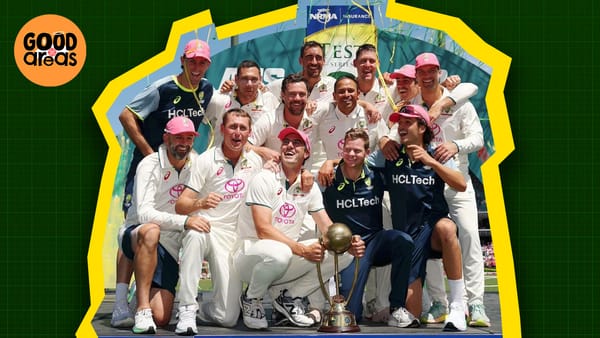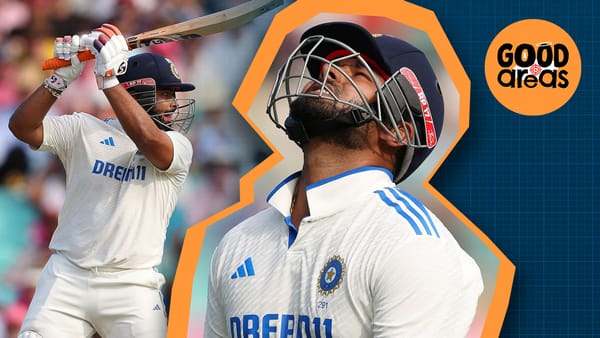Stoinis & Starc. Kusal's pull. Lahiru and the pace World Cup. And Phil Simmons quits.
Day 10 from the World Cup
Stoinis and spin
It was heading towards tense when Marcus Stoinis came in.
Sri Lanka built some pressure thanks to Aaron Finch's inability to either remember how to bat or be dismissed. And when the wicket of Maxwell went down, Australia still needed 69 off 46 balls.
Stoinis had other ideas, clubbing the second-fastest T20 World Cup 50 ever (Hi Yuvraj) and the fastest T20I fifty for Australia off just 17 balls.
It was a dramatic reversal of form for Australia against spin bowling – a real weakness of theirs in recent T20 cricket. Australia as a team average under 20 against spin bowling in the last two years, around the same mark as Ireland and Zimbabwe.

Sri Lanka's spinners, meanwhile have one of the lowest team bowling averages over the same period. On paper this could have been a bad matchup for Australia.
Perth is not traditionally a spinner's paradise. Still, it seemed as if Australia – first through Maxwell and then Stoinis – went in with a clear plan to go after them.
Maxwell has an excellent record against Sri Lanka, averaging 48 and striking at 176 compared to career figures of 28 and 151. His top score in the format the ridiculous 145* from 65 balls at Pallekelle in 2016.
He might have been roughed up today by pace, but he was brutal against spin. Hasaranga conceded two 6s and two 4s to him in his cameo of 23 from 12.
By the end of the game and Stoinis' onslaught, the figures were not pretty for Sri Lanka's spinners, particularly Hasaranga who went at 17.7 an over, conceding 53 from just 3 overs.
When David Warner got out early on to spin it looked as if a familiar weakness might rear its head again. Maxwell and Stoinis slapped that fear out of Perth.
Mitch Starc’s bowling position
Mitch Starc was not used in the first over today. And before you say, Finn Allen changed Australia's policy, Starc also didn't bowl the first over in a warm-up match at Canberra. However before that the last time for Australia 2014. That is three World Cups ago.

On 34 straight occasions he took the first over.
There could be a few reasons. One might be that it makes Australia to easy to game plan for. If everyone knows he will take the first over, that is a far easier option for the opposition. But I don't think that is it.
And there are a few possibilities. The one I think is possible is that Starc is a different bowler than he was before. Starc has become more of a wobbeball than swing bowler in Tests. It took him a long time to learn that, and many bowlers who make the change lose their ability to continually swing the ball. If Starc isn't swinging it, then there is really no reason to give him an over upfront. Hazlewood is also someone who can bowl that over.
But either way, Starc isn't the same T20 bowler he once was. That is because he has changed a little, but also because he plays T20 only a little.

In 2017 he didn't play a match of it. In 2018, one. That was pre-Covid (in case your brain has turned to mush).
And if you have forgotten how good Starc was with the white ball, he was player of the tournament in the 2015 World Cup, and then I think as good - if not better - in 2019. But in T20 during 2012, Starc played in 28 T20 matches across Big Bash, Blast, World Cup and Champions League. In all those, he took 59 wickets at just under 12, econ of 6.5 and took a wicket every 11 balls.

If you think that's a fluke year or helped by lower-quality comps. In 2015 he played 14 matches, took 21 wickets at just over 15, went at 6.87, and took wickets every 13 balls. That was all in the IPL except, one game against England.
So if we go from 2012 until 2016, and then look since then we he first stops playing games a lot. Well, yeah, he was way better back then.

But he's still Starc, and Australia isn't about to find another beanpole left arm with his pace and experience. So they have decided to move him into what looks like the enforcer middle-overs role.
Oh, and why am I talking about that? Because in that new role he took 1/23 from his four. And that included five wides he gifted at the death. I actually thought he was always more suited to this, the problem might be that so is Cummins. But it will be interesting to see what they do next with him.
Pace bowling
Sir Lanka are missing most of their first-choice seam bowlers right now. Dilshan Madushanka is the young left-armer who I was hoping to have a big tournament, but he was out without a game played, Dushmantha Chameera, their quick quick, is gone as well. And Pramod Madushan is there with a dodgy hamstring. That is not ideal for turning up to a Perth World Cup match for.
And then in the game, their backup southpaw seamer pacer Binura Fernando gets injured after five balls. With all that in mind, this should have been much easier for Australia.
However, Lahiru Kumara was bowling so well tonight that he almost made up for it alone. Cutting Finch in half so many times that he actually diced him. Then rattling Glenn Maxwell with a hit to the throat. We've seen a lot of fast bowling doing well so far, but this was different to the rest.
The pace bowlers so far at this tournament are averaging 22 runs per wicket. And that is with a lot of leg byes, and a few wides from extra bounce thrown in.

It's early in this tournament, but so far it is tracking as a tournament where the seamers are doing well at taking wickets.
But what has been interesting so far is that the best place to bowl in this world cup has been length.

Part of this comes from the theory on the reinforced seam of the Kookaburra, which means teams are bowling fuller. But also, these wickets aren't normal Australian wickets, baked by the hot sun. It's October, these were footy grounds in September. Even putting aside our old friend El Nina, it's not summer in Australia. Shield teams often move about early-season games. And we know that Rohit Sharma told the press that he wasn't sure whether they should look at the historical MCG data. As this was a wicket where teams never usually play T20 at this time.
As cricket stops being played in the southern parts of Australia, perhaps it will even out.
Kusal Mendis
Kusal Mendis is the current leading scorer at this World Cup.

We saw similar things with the Sri Lankan players last time because of the qualifiers. But he has been batting very well so far.
But what I love about him is his commitment to the pull shot. It's not uncommon for a shorter player to play it a lot. But he really uses it more than most. Especially when you consider he plays on wickets that don't bounce a lot.
There was no way he wasn't going to look for it in Perth. Sadly for him, he spooned one straight up early on. But I figured it was worth looking at just how often he does it compared to a regular batter. All players in T20 play a pull shut around 8% of the time. He's well over 12%, meaning he plays them 55% more often.

I now feel genuinely disappointed for him. Imagine going all the way to Western Australia and getting out playing your favourite shot that was built for that place.
Hobart to Perth
So Australia have their first win on the board, but in truth, they started this game with something of a headstart. Sri Lanka probably won't be thanking whoever designed the tournament schedule. On Sunday, having only just arrived from Geelong, they were in Hobart for one game. Then with Ireland beaten comfortably, they had to get on a plane to Perth.
And while there are at least direct flights between the two places, a 5 hour flight is not exactly what you want just before launching into your biggest game of the tournament.
Conditions wise the places could scarcely be more different too, even if Perth did appear slightly colder than usual today. But mostly it is about the bounce.
Sri Lanka got just one net session in Perth. That's before we get onto the fact that they are missing basically their entire frontline pace attack (in Perth!!!) were playing the tournament hosts and then lost a seamer halfway through the game.
It's incredible they kept themselves in the game that long.
Phil Simmons quits
The first domino has fallen in the west Indies and their two-time world cup cunning coach has quit. Phil Simmons helped shepherd the early West Indian champions into a team that really changed the way we thought about and played, T20.
His vision is no longer that cutting edge, and their tactics at a time in this tournament were a bit baffling. However, he was trying to coach a team with no batters who looked like they could consistently face 30 balls in a tournament that increasingly seems to be about that.
Phil becomes the 16th West Indies head coach that has quit or been fired since the turn of the century.
— Caribbean Cricket Podcast (@CaribCricket) 9:13 PM ∙ Oct 24, 2022
Only constant is we've remained dreadful.
There are some in the region who actually believe we're now going to become good after this 😃😃
Based on the above tweet, I think it might not be the coach.
What I want to know is, what the Cricket West Indies did to build on what their team had done from 2010 until 2018. A lot of that happened through Simmons and ofcourse the freelancers playing in all the leagues. But the CWI try and facilitate or grow it. Because I didn't see anything, and Daren Sammy seemed to say the same thing when they won in 2016.
I think it is fair to say that Simmons probably should have moved on from the white ball coaching duties, but also admit that it will instantly fix everything. Or, maybe, anything.




